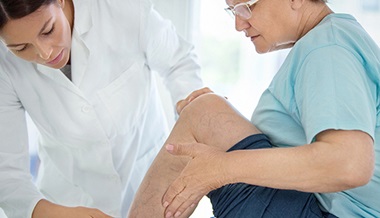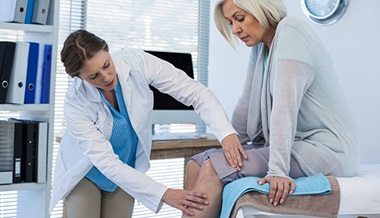Claudication
What is claudication?
Claudication is pain in your thigh, calf, or buttocks that happens when you walk. It can make you limp. It may be a symptom of peripheral artery disease (PAD). This is when narrowed or blocked arteries reduce the blood flow to your legs.
At first, claudication pain occurs when you walk a certain distance and goes away when you rest. But as the disease gets worse, the pain can occur when you walk shorter distances. Over time, you may no longer be able to walk because the pain is so severe.
Claudication is linked to health conditions that also increase your risk for heart attack or stroke. So you should be checked and possibly treated for artery disease in other parts of the body.
What causes claudication?
Peripheral artery disease (PAD) is very common, mainly in people over age 50. PAD is caused by narrowed or blocked arteries in the legs or in the body’s main artery (the aorta). This can reduce blood flow to muscles in your calf, thigh, or buttocks. This decreased blood flow may cause the pain that leads to claudication.
The blockage usually happens because of narrowed and hardened arteries (atherosclerosis). This is caused by plaque build-up inside the arteries. Plaque is made up of fat, cholesterol, calcium, and other substances in the blood. This plaque build-up can also affect your heart arteries. It can lead to chest pain or a heart attack.
Blockages in the leg are most common in the thigh and behind the knee. But they can also occur in other parts of the body such as the aorta, groin, or belly. You can have more than 1 blockage.
Who is at risk for claudication?
Risk factors for claudication are the same as those for hardened arteries (atherosclerosis). They include:
-
Smoking
-
Diabetes
-
Being overweight
-
Not being active
-
High cholesterol
-
High blood pressure
-
Family history of atherosclerosis or claudication
-
Older age (55 for men, 60 for women)
What are the symptoms of claudication?
Claudication is a symptom of a narrowing or blockage of an artery.
Typical symptoms of claudication include:
-
Pain, a burning feeling, or a tired feeling in the legs and buttocks when you walk
-
Shiny, hairless, blotchy foot skin that may get sores
-
The leg is pale when raised (elevated) and red when lowered
-
Cold feet
-
Impotence in men
-
Leg pain at night in bed
Pain when you are resting is a sign that your blocked arteries have become worse.
Claudication symptoms may look like other health conditions. Always see your healthcare provider for a diagnosis.
How is claudication diagnosed?
Diagnosis focuses on finding narrowed arteries in your legs. Your healthcare provider will take your medical history and give you an exam. You may also have tests such as:
-
Ankle-brachial index (ABI). For this test, blood pressure is taken in your arms and legs. The two measurements are compared. ABI is done with a regular blood pressure cuff and a Doppler ultrasound device.
-
Auscultation. In this test, the doctor listens to the arteries in your belly (abdomen) or legs using a stethoscope. This is done to see if a whooshing sound (called a bruit) is present. A bruit means that blood flow is limited in the area.
-
Doppler ultrasound. This test uses a Doppler probe inside an ultrasound probe to check the speed and direction of blood flow in the blood vessels. It does this by bouncing high-frequency sound waves off of red blood cells. The probe picks up the reflected sound waves and sends them to an amplifier so they can be heard. If there is no sound, or a very faint sound, then blood flow may be blocked.
-
Angiogram (also called an arteriogram). This is an X-ray image of the blood vessels. It may be done to find out if there is a blockage and how large it is. A thin, flexible tube is put into a leg artery. A contrast dye is injected into the artery. The contrast dye makes the arteries and veins show up clearly on the X-ray.
How is claudication treated?
Your healthcare provider will create a treatment plan for you based on:
-
Your age, overall health, and medical history
-
How serious your case is
-
Where the blockage is found
-
Your signs and symptoms
-
How well you handle certain medicines, treatments, or therapies
-
If your condition is expected to get worse
-
Your opinion or preference
Claudication is often first treated by making lifestyle changes. This can reduce your risk factors for peripheral artery disease (PAD). Medicine and surgery may be needed in some cases. Treatment may include:
-
Stopping smoking
-
Exercising, such as walking
-
Having a diet low in saturated fats
-
Treating related health problems, such as high cholesterol, high blood pressure, or high blood sugar levels. This may involve changes in diet, exercise, or medicine.
-
Taking medicines that help prevent blood clots, such as aspirin or other medicines
-
Taking medicines that may improve walking distances in some cases
In severe cases, blood flow may be fully or almost fully blocked. Then a procedure or surgery may be needed. This may include:
-
Angioplasty. A tube (catheter) is used to make a larger opening in the vessel to increase blood flow. Often, a tiny coil (stent) is expanded inside the blocked artery to open the blocked area. The stent is left in place.
-
Surgery. This may be needed to open the blocked artery.
In very rare cases, if all other treatments have not worked, the leg may need to be removed (amputated). People who smoke or who have diabetes are at increased risk for amputation.
What can I do to prevent claudication?
Hardened arteries (atherosclerosis) that cause claudication in your legs can also affect the blood vessels in your heart and brain. For this reason, it is very important to reduce your risk factors for atherosclerosis. This can help prevent claudication as well as heart attack and stroke.
You can reduce your risk factors by:
-
Treating high blood pressure
-
Lowering your LDL (bad) cholesterol, as directed by your doctor
-
Raising your HDL (good) cholesterol, as directed by your doctor
-
Lowering fats in your blood (triglycerides)
-
Staying at a normal weight
-
Increasing your physical activity, especially walking
-
Controlling blood sugar levels if you have diabetes
-
Stopping smoking and avoiding all types of tobacco or nicotine
When should I call my healthcare provider?
If your symptoms get worse or you have new symptoms, call your healthcare provider.
Key points
-
Claudication is pain in your thigh, calf, or buttocks that happens when you walk a certain distance.
-
As the condition gets worse, the pain occurs when you walk shorter distances. Over time, it can become too painful to walk.
-
It may be a symptom of peripheral artery disease (PAD). This is when narrowed or blocked arteries reduce the blood flow to your arms and legs.
-
Risk factors are the same as those for hardened arteries (atherosclerosis).
-
Treatment focuses first on making lifestyle changes. Medicine and surgery may also be needed.





